Snake in the Grass
Anyone expecting the usual Ayckbourn English-middle-class-living-room comedy will be disappointed by this play. Written in 2004, and billed as “a wily and wicked thriller”, it is one of three of Ayckbourn’s plays that make a foray into the supernatural. It follows Haunting Julia (1994) and precedes Life and Beth (2009) – which have been linked as a ghost story trilogy titled Things That Go Bump in the Night.
Snake in the Grass is a black comedy with overtones of the supernatural. As usual with Ayckbourn , family relationships are the basis of the plot, but in this play, Ayckbourn ventures beyond the usual cut and thrust of jealousy and resentment to address some contemporary issues and their social and psychological effects. Not your usual Ayckbourn!

The play revolves around sisters Annabel and Miriam who meet for the first time in many years. Following the death of their father, whom Miriam has lived with all her life, Annabel, fresh from a failed business and an abusive marriage, has returned from Tasmania to begin a new life in England with Miriam.
In the decaying garden of the family home – complete with overgrown tennis court and dilapidated summer house – Annabel waits for Miriam. The house is locked. She has no key. She paces, tired after the flight. Instead of Miriam, she is greeted by a nurse, Alice, who was caring for her father until being dismissed by Miriam for apparent misconduct. She presents a letter purported to be written by her former patient. In it he accuses Miriam of a litany of mistreatment including doubling his medication and pushing him down the stairs. In short, Alice accuses Miriam of murder and promises to return next day with her blackmail proposition.
Miriam, faced with the accusation by Annabel, dissolves into a wallow of tears and self pity, cites the terrible life she has led under their father’s tyrannical rule, accuses Annabel of running away and leaving her to face it on her own – and admits her guilt.
And that’s just the beginning! Murder. Blackmail. Abuse. And ghosts of the past. Not your usual Ayckbourn!
Director Faith Jessel has chosen to accentuate the darkness of the play in her production. The set, designed by Maureen Cartledge and lit by Heidi Bronson, is almost macabre. Paint peels from the walls of the summer house. Vines hang from the wire surrounds of an old tennis court. Dead leaves litter the rise of the garden and the cover of an old well. It is a shadowy, unsavoury place.
 As she enters, Annabel, played by Diane Rowden, presents a contrast to the decay around her. She is smart, well dressed, competent, impatient – but just a little vulnerable. Rowden maintains that vulnerability in a performance that is sustained and almost understated, apart from a rather long monologue in the second Act that somewhat pulls the pace of the play.
As she enters, Annabel, played by Diane Rowden, presents a contrast to the decay around her. She is smart, well dressed, competent, impatient – but just a little vulnerable. Rowden maintains that vulnerability in a performance that is sustained and almost understated, apart from a rather long monologue in the second Act that somewhat pulls the pace of the play.
Annette Rowlison plays up the deviousness of Miriam’s Machiavellian character. She is in turn, whimpering and tearful, strident and accusative, calculating and manipulative, cowering and energetic. After a decade of direction and production work both here and in England, it is easy to see how the role of Miriam attracted Rowlison back to the stage.
Annette van Roden plays the nurse Alice. In contrast to the sisters, she is stridently working class, loud and flamboyant. Jessel has conceded to Ayckbourn’s more usual caricature and comedy in this portrayal and allowed it to go just a little over the top.
Any more detail would spoil the success of the plot and how the production makes it work. It’s a different sort of thriller and one that fans of both Ayckbourn and the thriller genre are sure to appreciate.
Carol Wimmer
Images (from top): (from left to right) Annette Rowlison, Annette van Roden and Diane Howden; (from left to right) Diane Howden and Annette Rowlison & (from left to right) Annette van Roden and Annette Rowlison.
Subscribe to our E-Newsletter, buy our latest print edition or find a Performing Arts book at Book Nook.

